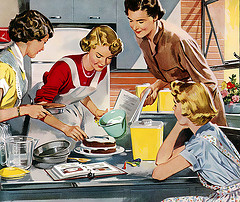
“Stay-at-home mother” evokes black and white images of well-coiffed women in starched aprons. Rather than a vestige of a bygone era, stay-at-home moms are on the rise, according to the findings of a new Pew Research study. In 2012, 29% of women with children under the age of 18 stayed home, a number that has been on the rise since 1999 and is 3% higher than in 2008.
However, while more women are staying home with their children, the face of the stay-at-home mom has changed dramatically since the 1950s “Leave It to Beaver” days. Stay-at-home moms today are less educated and more likely to live in poverty than working moms. Younger mothers and immigrant mothers also make up a good portion of stay-at-home moms.
The story of why mothers are staying home is more complex than you may imagine and has more to do with the poor labor market, the exorbitant price of child care, and the contemporary structure of work. In a recent interview with Wisconsin Public Radio, Barbara Risman, a sociologist at the University of Illinois at Chicago, spoke about how this report has been picked up by the mainstream media:
What’s surprising to me is the headlines and how it’s portrayed in the news. Although the numbers are going up, when you look at what mothers say, 6% of the mothers in this study say they are home because they can’t find a job. When you take those 6% of mothers out, the results are rather flat. Part of the real story here then is that it’s hard to find a job that allows you to work and covers your child care, particularly if you have less education and your earning potential isn’t very high.
These days stay-at-home moms, who are more likely to be less educated, are not be able to make enough money for working to even be worthwhile. Many times, their pay wouldn’t actually cover the cost of child care. Beyond these important financial considerations, lower wage shift work makes it extremely difficult to coordinate child care in the midst of work schedules that change on a weekly basis.
For highly-educated, formerly-professional stay-at-home moms, it’s not that they’re “opting out” from the labor force, but they’re being pushed out by the “all-or-nothing” structure of professional jobs with 24/7 demands for worker availability. The nature of these jobs makes it very hard to be both a worker and a parent.
![]()








